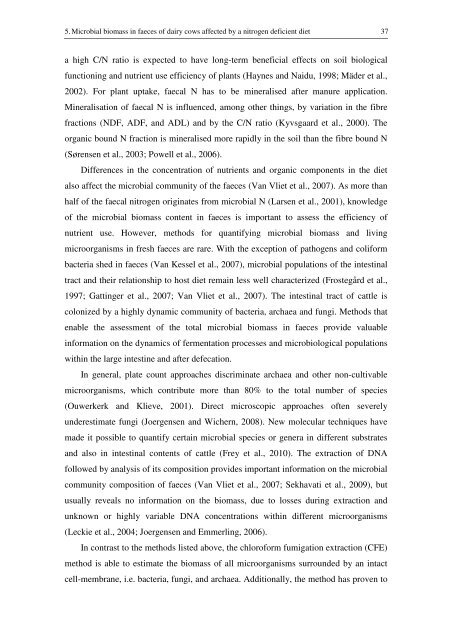Fütterungsbedingte mikrobielle Zusammensetzung von Rinderkot ...
Fütterungsbedingte mikrobielle Zusammensetzung von Rinderkot ...
Fütterungsbedingte mikrobielle Zusammensetzung von Rinderkot ...
Create successful ePaper yourself
Turn your PDF publications into a flip-book with our unique Google optimized e-Paper software.
5. Microbial biomass in faeces of dairy cows affected by a nitrogen deficient diet 37<br />
a high C/N ratio is expected to have long-term beneficial effects on soil biological<br />
functioning and nutrient use efficiency of plants (Haynes and Naidu, 1998; Mäder et al.,<br />
2002). For plant uptake, faecal N has to be mineralised after manure application.<br />
Mineralisation of faecal N is influenced, among other things, by variation in the fibre<br />
fractions (NDF, ADF, and ADL) and by the C/N ratio (Kyvsgaard et al., 2000). The<br />
organic bound N fraction is mineralised more rapidly in the soil than the fibre bound N<br />
(Sørensen et al., 2003; Powell et al., 2006).<br />
Differences in the concentration of nutrients and organic components in the diet<br />
also affect the microbial community of the faeces (Van Vliet et al., 2007). As more than<br />
half of the faecal nitrogen originates from microbial N (Larsen et al., 2001), knowledge<br />
of the microbial biomass content in faeces is important to assess the efficiency of<br />
nutrient use. However, methods for quantifying microbial biomass and living<br />
microorganisms in fresh faeces are rare. With the exception of pathogens and coliform<br />
bacteria shed in faeces (Van Kessel et al., 2007), microbial populations of the intestinal<br />
tract and their relationship to host diet remain less well characterized (Frostegård et al.,<br />
1997; Gattinger et al., 2007; Van Vliet et al., 2007). The intestinal tract of cattle is<br />
colonized by a highly dynamic community of bacteria, archaea and fungi. Methods that<br />
enable the assessment of the total microbial biomass in faeces provide valuable<br />
information on the dynamics of fermentation processes and microbiological populations<br />
within the large intestine and after defecation.<br />
In general, plate count approaches discriminate archaea and other non-cultivable<br />
microorganisms, which contribute more than 80% to the total number of species<br />
(Ouwerkerk and Klieve, 2001). Direct microscopic approaches often severely<br />
underestimate fungi (Joergensen and Wichern, 2008). New molecular techniques have<br />
made it possible to quantify certain microbial species or genera in different substrates<br />
and also in intestinal contents of cattle (Frey et al., 2010). The extraction of DNA<br />
followed by analysis of its composition provides important information on the microbial<br />
community composition of faeces (Van Vliet et al., 2007; Sekhavati et al., 2009), but<br />
usually reveals no information on the biomass, due to losses during extraction and<br />
unknown or highly variable DNA concentrations within different microorganisms<br />
(Leckie et al., 2004; Joergensen and Emmerling, 2006).<br />
In contrast to the methods listed above, the chloroform fumigation extraction (CFE)<br />
method is able to estimate the biomass of all microorganisms surrounded by an intact<br />
cell-membrane, i.e. bacteria, fungi, and archaea. Additionally, the method has proven to
















